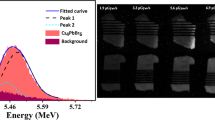Abstract
Thin film of CsI was deposited on glass substrate using the sol–gel technique. The different surface morphology of sol–gel films with respect to evaporated films can be assumed as the main cause of the more QE (quantum efficiency) of sol–gel CsI films. The thin films were characterized by scanning electron microscopy, Atomic force microscopy and X-ray diffraction, and optical properties were followed by optical absorption and UV–vis fluorescence. Also, thin films and bulk samples were studied by fluorescence spectroscopy. The increased contribution of emission spectrum of the nanocrystal in thin film samples in comparison with bulk was observed. In thin films, nanocrystals are more closely in contact with the network and this affects the luminescence features. So the energy transfer from the matrix to nanocrystals, which is a key characteristic for scintillation detectors, was investigated in the two systems. Scintillation tests were performed on the CsI thin film and bulk sample by photo multiplier tube-based material exposed to alpha irradiation.
Graphical Abstract
Thin film of CsI was deposited on glass substrate using the sol–gel technique. The increased contribution of emission spectrum of the nanocrystal in thin film samples in comparison with bulk was observed. Also, the energy transfer from the matrix to nanocrystals, which is a key characteristic for scintillation detectors, was investigated in the two systems. Figure 3 shows the SEM image of CsI thin film. SEM studies shows that the particles are distributed uniformly and mostly of homogeneous morphology at high magnification. SEM image of CsI thin film with the molar ratio about 10:1 for EtOH:TEOS and nine times deposited at magnification 100 kx.










Similar content being viewed by others
References
Rezaee KH, Hoseini SA, Faripour H, Faeiz MR, Abdi MR, Soltani N, Aghay Khareiky A (2014) Thermoluminescence behavior of KClXBr 1-X: in mixed crystals exposed to gamma radiation. Cryst Growth 402:161–168
Shinde S, Singh SG, Sen S, Gadkari SC, Gupta SK (2013) Temperature dependent photoluminescence studies in CsI:tl films with varying thicknesses. Phys Status Solidi B 251:1–7
Fujiedat I, Cho G, Drewery J, Gee T, Jing T, Kaplan SN, Perez-Mendez V, Wildermuth D (1991) X-ray and charged particle detection with CsI(T1) layer coupled to a-Si:H photodiode layers. J Trans Nucl Sci 38:255–262
Kaushik N, Sharma P (2014) Metallic glass thin films for potential biomedical applications. J Biomed Mater Res, Part B 102:1544–1552
Eskandari A, Sangpour P, Vaezi MR (2014) Hydrophilic Cu2O nanostructured thin films prepared by facile spin coating method: investigation of surface energy and roughness. Mater Chem Phys 147:1204–1209
Simons DJ, Fraser GW, De Korte PAJ, Pearson JF, De Jong L (1987) UV and XUV quantum detection efficiencies of CsI-coated microchannel plates. Nucl Instrum Methods A 261:579–586
Kumar K, Arun P, Kant CR, Mehra NC, Mathew V (2010) The effect of cesium metal clusters on the optical properties of cesium iodide thin films. Appl Phys A 99:305–310
Breskin A (1996) CsI UV photocathodes: history and mystery. Nucl Instrum Methods A 371:116–136
Friese J, Gernhauser R, Homolka J, Kastenmuller A, Komor PM, Peter M, Zeitelhack K, Kienle P, Korner HJ (1999) Enhanced quantum efficiency for CsI grown on a graphite-based substrate coating. Nucl Instrum Methods A 438:86–93
Cha BK, Kim JY, Kim TJ, Sim C, Cho G (2010) Fabrication and imaging characterization of high sensitive CsI(Tl) and Gd2O2S2(Tb) scintillator screens for X-ray imaging. Radiat Meas 45:742–745
Chen HL, Hsu JC, Lin YH (2008) Luminescence efficiency and optical property of CsI and NaI films. In: 51st SVC annual technical conference
Nitti MA, Valentine A, Senesi GS, Ventruti G, Nappi E, Casamassima G (2005) Ion-beam sputtering deposition of CsI thin films. Appl Phys A 80:1789–1791
Withers NJ, Akins BA, Rivera AC, Plumley JB, Smolyakov GA, Osinski M (2009) Lead-iodide-based nanoscintillators for detection of ionizing Radiation. doi:10.1117/12.819004
Shakti N (2010) Structural and optical properties of sol-gel prepared ZnO thin film. App Phys Res 2:19–28
Nadaraia L, Jalabadze N, Chedia R, Antadze M, Khundadze L (2010) Preparation of tungstate nanopowders by Sol-Gel method. J Trans Nucl Sci 57:1370–1376
Shilova OA (2013) Synthesis and structure features of composite silicate and hybrid TEOS-derived thin films doped by inorganic and organic additives. J Sol-Gel Sci Techn 68:387–410
Stefanescu M, Stoia M, Stefanescu O (2007) Thermal and FT-IR study of the hybrid ethylene-glycol–silica matrix. J Sol-Gel Sci Techn 41:71–78
Swanepoel R (1983) Determination of the thickness and optical constants of amorphous silicon. J Phys E: Sci Instrum 16:1214–1217
Jun MC, Koh JH (2013) Effects of annealing temperature on properties of al-doped ZnO thin films prepared by Sol-Gel dip-coating. J Electr Eng Technol 8:163–167
Nishimura H, Sakata M, Tsujimoto T, Nakayama M (1995) Origin of the 4.1_eV luminescence in pure CsI scintillator. Phys Rev B Condens Matter Mater Phys 51:2167–2172
Author information
Authors and Affiliations
Corresponding author
Rights and permissions
About this article
Cite this article
Farzaneh, A., Abdi, M.R., Saraee, K.R.E. et al. The preparation of cesium-iodide thin films via sol–gel method for the detection of ionizing radiation. J Sol-Gel Sci Technol 78, 313–321 (2016). https://doi.org/10.1007/s10971-016-3959-6
Received:
Accepted:
Published:
Issue Date:
DOI: https://doi.org/10.1007/s10971-016-3959-6




